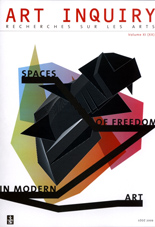Aesthetic Illusions of Freedom? “Aesthetic Ideology” and a Praise of Aesthetic Appearance
Aesthetic Illusions of Freedom? “Aesthetic Ideology” and a Praise of Aesthetic Appearance
Author(s): Agnieszka Rejniak-MajewskaSubject(s): Philosophy
Published by: Łódzkie Towarzystwo Naukowe
Keywords: aesthetic appearance; autonomy; freedom; ideology; Friedrich Schiller; Jacques Rancière
Summary/Abstract: The article concerns two opposite modes of interpretation related to the question of aesthetic autonomy: in the first, art and aesthetic experience is recognized as a utopian realm of freedom; in the second this assumption is challenged by bringing to the fore the social and ideological premises in which such ideal of aesthetic freedom is grounded. My point of departure here is the original connection which was established between aesthetic experience and the idea of freedom in Kant’s and Schiller’s aesthetics, especially Schiller’s conception of aesthetic state as the realization of human freedom. In analyzing Meyer Schapiro’s interpretation of Abstract Expressionism, I present a more restricted modern version of this conception, pointing out the paradox which was implicit in considering art as a major area of human freedom and authenticity (which resulted in confining these values to the isolated domain of art). Such limitation implicit in the notion of freedom discussed in the tradition of aesthetic thought was also the object of Terry Eagleton’s criticism: he found there a tangle of emancipatory impulses and restricted bourgeois notion of autonomy, which from his Marxist point of view seemed deeply problematic. In Eagleton’s perspective, as well as in Pierre Bourdieu’s sociological interpretation, freedom associated with aesthetic experience is a form of illusion, because it is already inscribed in the existing symbolical hierarchies and social relations of power. According to Bourdieu, one may take or invent a distinct position in the field of art, but freeing oneself from the socially and historically determined notions which structure our thinking and feeling is possible only on the higher level of theoretical reflection. A different view on this question is offered by the art critics Hal Foster and Banjamin Buchloh, who despite their earlier anti-aesthetic positions (countering the modernist notion of artistic autonomy), defend the specificity of the “aesthetic structure” of a work of art, by recognizing its emancipatory potential – a unique “suspension of power”, which offers a more effective form of resistance and critique than whatever may be proposed by critical theory. Such irreducible, utopian dimension of aesthetic experience is also defended by Jacques Rancière, in his reframing of aesthetics and politics, which is also a polemic with Bourdieu. At the same time, in his interpretation of Schiller’s aesthetics, Rancière emphasizes the irrevocable linking of art and life practice: the crucial entanglement of aesthetic autonomy and heteronomy, which prevents art from taking a definite place, and saves its utopian promise.
Journal: Art Inquiry
- Issue Year: 2009
- Issue No: 11
- Page Range: 71-90
- Page Count: 20
- Language: English

